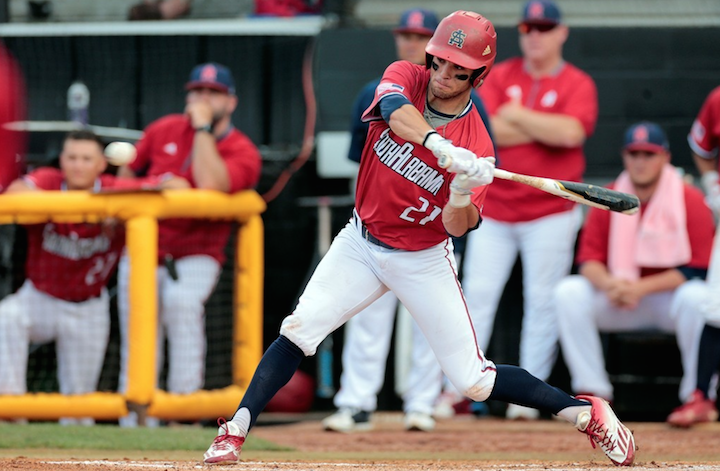It’s no secret the Royals are in the market to rebuild their farm system in 2018, and likely the next year or two after as they look to get into rebuilding into a winner. With a strong 2018 draft class and as many as six picks in the top 65 selections in the draft, Dayton Moore and staff will have a real opportunity to reload the farm system. If they do end up with five or six selections that high, then they should have the draft pool to add quality throughout their selections despite not making their first selection until the 18th overall pick. Last year, prior to the draft, I explained how the Royals lacked up the middle talent and that remains despite the addition of Michael Gigliotti and the fast rise of Nicky Lopez, but for a front office that loves athletes and tools up the middle, it is still lacking in the Royals system.
One such player who might fit that bill is similar to the two I just mentioned in that he’s an up the middle player, who like Gigs was lightly recruited in high school, but could fill the hole up the middle in the future. Hailing from Covington, Louisiana, Travis Swaggerty didn’t get a look from his local powerhouses at LSU or the Sun Belt’s Louisiana Lafayette despite being named Baton Rouge Large School Player of the Year. Despite those failures on the part of those schools, South Alabama’s head coach Mark Calvi saw one heck of an athlete who could run and give him a possible explosive option up the middle that he could develop into a good player. Fortunately for Calvi, he didn’t have to wait long for Swaggerty to develop after going out during his freshman year and leading the squad in hitting (.303), and ranking third in the Sun Belt in OBP (.431) to become a member of the Louisville Slugger Freshman All-American team.
Building on that strong frosh campaign, Swaggerty upped his OPS .200 points as the centerfielder connected on six more home runs, upping his batting average to .361. These numbers helped him become the first South Alabama baseball player to be selected for the USA Baseball Collegiate team. Despite that small school background, Swaggerty opened eyes again with Team USA. He led the squad in runs scored while pacing the defense in center and finishing as the team’s third most productive hitter at .328/.449/.406. This work with a wood bat answered some questions scouts likely had and gave him a good building block to lead into his likely last season at South Alabama.
The Tools
At 5’11” 180 lbs, Swaggerty’s game is built more about the sum of all the parts instead of just one or two tools, exhibiting average or better tools across the board. The speed is his one standout tool, grading as a 60 to 65 which is enough with his baseball acumen to stick in centerfield while he’s still young. He pairs that speed in the outfield with an average throwing left-handed arm to make a plus defender at the most important spot in the outfield. Offensively, that speed has generated 45 stolen bases between his two college campaigns and his time with Team USA. The stolen base percentage isn’t great in college (70%) but taking extra bases on balls in play is a regular part of his game and one reason he will be a lock to leadoff or hit second in a major league order should he make it.
The other reason he will hit that high is that he controls the zone well, walking more times than he struck out last season and just seven fewer times during his freshman season. That skill combined with plus bat speed and strong wrists help the smallish hitter barrel plenty of balls and incorporate a gap to gap approach the generates more extra-base hits and home runs than one might expect. The obvious comp for a player here is Andrew Benintendi and through two seasons the statistical comparisons to the current Red Sox outfielder are quite accurate as you can see here. Will Swaggerty make the leap that Andrew made in his final season to push him in the Top 10? That’s quite possible, but for now there remains a chance that he’s available to the Royals with their 18th selection.
Draft Strategy
With a large draft pool, there are a number of different strategies a team like the Royals, who are selecting later, can employ. Something the Royals may want to do with so many selections is select a previously “highly thought of” player with a later pick. One such player is Oregon State’s Drew Rasmussen who had to have his second Tommy John surgery after being drafted with the 31st overall pick and going unsigned with Tampa Bay. On talent alone Rasmussen is a lock first rounder, but the surgeries will likely push him out of the first three rounds of the draft. A pitcher with a mid-90s fastball and a pair of average pitches along with a college pedigree would be an outstanding selection for a team like the Royals with multiple selections. A selection of Rasmussen won’t break the bank depending on the slot used, adds a quick moving arm should he stay healthy, and essentially works like adding a later round first round pick. If not Rasmussen, look for another injured player to perhaps be chosen by the Royals.
Follow me on Twitter @ClintScoles
Featured Photo courtesy usajaguars.com
